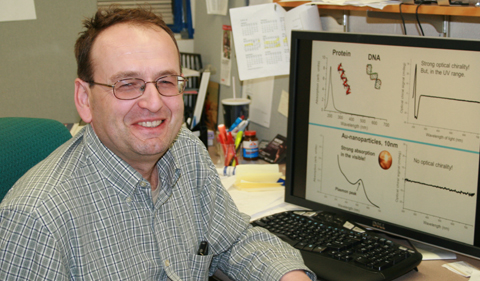
Distinguished Professor Alexander Govorov
Research by Dr. Alexander Govorov, Distinguished Professor of Physics & Astronomy, was featured in an Inhabitat article headlined “Hot electron research could open up greater efficiencies for solar energy.”
Hot electron research is heating up solar and renewable energy research, according to the Department of Energy’s Argonne National Laboratory. Nanoscientists there uncovered quicker ways to convert power from light to energetic or hot electrons – and their methods could allow for higher efficiencies for solar power.
Argonne researchers and collaborators created hybrid nanomaterials – smaller than the width of human hair – “to harness the full energy of photons,” according to the laboratory. The result was what are called hot electrons that “carry the same amount of energy as a photon that strikes nanomaterial components” and could lead to large advances in photovoltaics and photocatalytic water splitting — where materials turn solar energy into hydrogen fuel….
The journal Nature Communications published the research online (“Enhanced generation and anisotropic Coulomb scattering of hot electrons in an ultra-broadband plasmonic nanopatch metasurface“) in October. Scientists from Duke University, the University of Electronic Science and Technology of China, and Ohio University contributed.
Govorov and Visiting Scientist Xiang-Tian Kong are the Ohio University researchers involved. They motivated the study and provided the quantum theory, which explained why this structure is so efficient for generation of hot electrons under illumination. Using computer simulations, the researchers from Ohio University have shown that the generation of hot electrons becomes very efficient in the vicinity of the so-called electromagnetic hot spots in a hybrid nanostructure.
Also read about this research in “‘Hot’ Electrons Heat Up Solar Energy Research” by Argonne National Laboratory in R&D Magazine.
Abstract: The creation of energetic electrons through plasmon excitation of nanostructures before thermalization has been proposed for a wide number of applications in optical energy conversion and ultrafast nanophotonics. However, the use of “nonthermal” electrons is primarily limited by both a low generation efficiency and their ultrafast decay. We report experimental and theoretical results on the use of broadband plasmonic nanopatch metasurfaces comprising a gold substrate coupled to silver nanocubes that produce large concentrations of hot electrons, which we measure using transient absorption spectroscopy. We find evidence for three subpopulations of nonthermal carriers, which we propose arise from anisotropic electron–electron scattering within sp-bands near the Fermi surface. The bimetallic character of the metasurface strongly impacts the physics, with dissipation occurring primarily in the gold, whereas the quantum process of hot electron generation takes place in both components. Our calculations show that the choice of geometry and materials is crucial for producing strong ultrafast nonthermal electron components.



















Comments